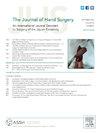Immunohistochemical Investigation of Mechanoreceptors Within the Injured Scapholunate Ligament
IF 2.1
2区 医学
Q2 ORTHOPEDICS
引用次数: 0
Abstract
Purpose
Scapholunate ligaments (SLLs) play a well-established role in maintaining carpal alignment and kinematics, and are innervated with sensory mechanoreceptors located within the ligaments. They are involved in the afferent arc of dynamic wrist stability. The aim of this study was to describe the changes in these mechanoreceptor populations in injured SLLs.
Methods
Injured SLLs were collected from human wrists at the time of SLL reconstruction or limited wrist fusion, where the ligament remnants would otherwise be discarded. These specimens were formalin-fixed and paraffin-embedded for immunohistochemical analysis to identify mechanoreceptors, which were then classified by type and location within the ligament.
Results
A total of 15 ligaments were collected, with the interval from injury ranging from 39 days–20 years. Eleven ligaments were collected less than one year after injury, and four ligaments were collected two years or more after injury. A total of 66 mechanoreceptors were identified, with 50 mechanoreceptors identified in nine of the 11 specimens collected less than one year after injury. In this group, 54% of the mechanoreceptors resided in the volar subunit, 20% in the dorsal subunit, and 26% in the proximal subunit. Two of the four specimens collected two years or later after injury contained mechanoreceptors, all of which were located in the dorsal subunit. Increasing time from injury demonstrated a decline in mechanoreceptor numbers within the volar subunit.
Conclusions
Mechanoreceptors were consistently located in the SLL, particularly in the volar subunit of specimens collected less than one year after injury.
Clinical relevance
Ligament reconstruction techniques aim to primarily reconstitute the biomechanical function of the disrupted SLL; however, re-establishing the afferent proprioceptive capacity of the SLL may be a secondary objective. This suggests the need to consider the reconstruction of its volar subunit particularly in those managed within one year of injury.
舟月骨韧带损伤机械感受器的免疫组化研究。
目的:舟月骨韧带(SLLs)在维持腕关节对齐和运动学方面发挥着重要作用,并受位于韧带内的感觉机械感受器的支配。它们参与动态手腕稳定的传入弧。本研究的目的是描述这些机械受体群体在损伤的SLLs中的变化。方法:在进行腕部韧带重建或有限的腕部融合术时,从人腕部收集受伤的韧带,否则将丢弃残余韧带。这些标本经福尔马林固定和石蜡包埋进行免疫组织化学分析,以确定机械感受器,然后根据韧带内的类型和位置进行分类。结果:共收集到15条韧带,损伤时间为39天~ 20年。11条韧带在伤后1年内收集,4条韧带在伤后2年或更长时间收集。共鉴定出66个机械感受器,在受伤后不到一年采集的11个标本中,有9个标本鉴定出50个机械感受器。在这一组中,54%的机械感受器位于掌侧亚基,20%位于背侧亚基,26%位于近端亚基。损伤后2年或2年后采集的4个标本中有2个含有机械感受器,均位于背侧亚基。损伤时间的延长表明掌侧亚基内机械感受器数量的减少。结论:机械感受器始终位于SLL,特别是在受伤后不到一年的标本中掌侧亚基。临床意义:韧带重建技术的主要目的是重建断裂的韧带的生物力学功能;然而,重建SLL的传入本体感觉能力可能是次要目标。这表明需要考虑掌侧亚单位的重建,特别是在受伤后一年内进行治疗的患者。
本文章由计算机程序翻译,如有差异,请以英文原文为准。
求助全文
约1分钟内获得全文
求助全文
来源期刊
CiteScore
3.20
自引率
10.50%
发文量
402
审稿时长
12 weeks
期刊介绍:
The Journal of Hand Surgery publishes original, peer-reviewed articles related to the pathophysiology, diagnosis, and treatment of diseases and conditions of the upper extremity; these include both clinical and basic science studies, along with case reports. Special features include Review Articles (including Current Concepts and The Hand Surgery Landscape), Reviews of Books and Media, and Letters to the Editor.

 求助内容:
求助内容: 应助结果提醒方式:
应助结果提醒方式:


